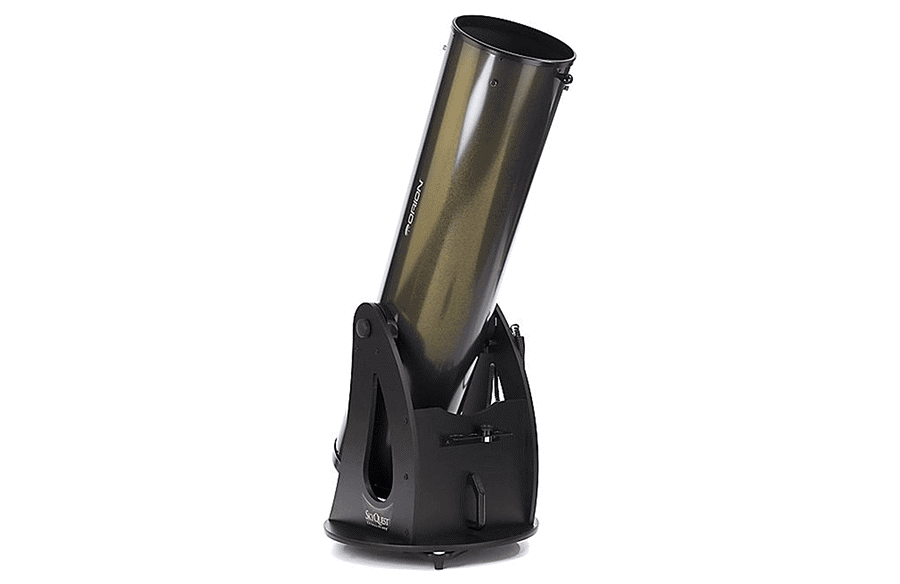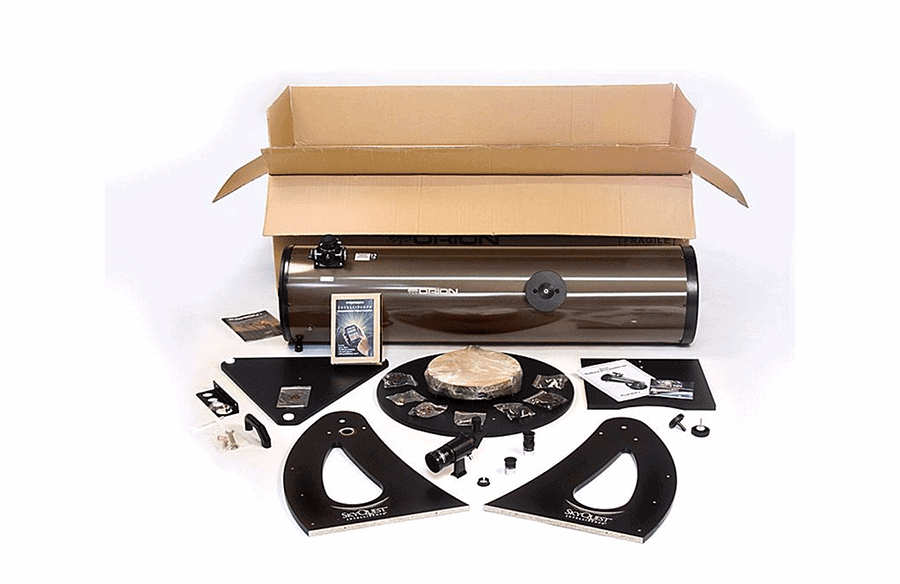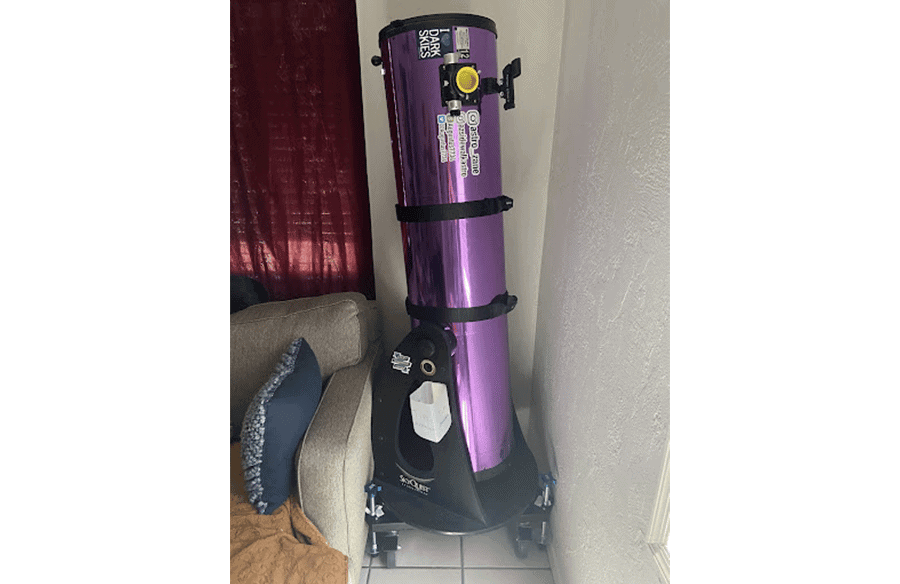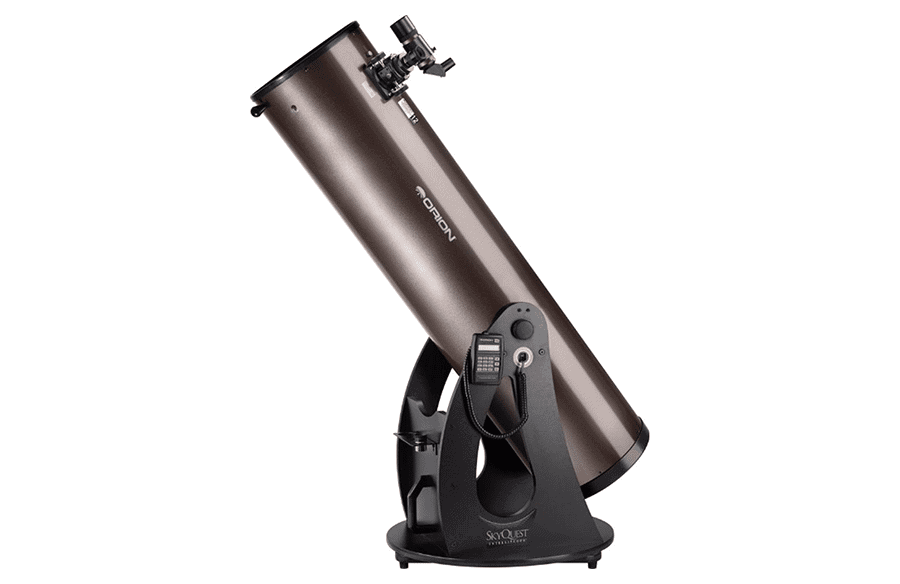The Orion SkyQuest XT12i is a massive instrument designed for demanding observers, and one of the less expensive 12” Dobsonians available, mainly due to its simple build. The XT12i costs only a bit more than its non-computerized competitors, but its Intelliscope mount makes it a bit easier to use – and is a bit more lightweight too.
A 12” Dobsonian like the SkyQuest XT12i provides tremendous bang for your buck in terms of what you can see, delivering images far brighter and sharper than a smaller 8” Dobsonian and significantly better than a 10” instrument, while still not towering over most users or requiring an extensive assembly process.
The big tube is also sure to impress even to people who aren’t interested in astronomy.
The SkyQuest XT12i is a big enough telescope that there are a few considerations involved when considering purchasing and transporting one. For starters, the tube is long enough that it won’t fit across the back of any standard vehicle unless you drive a full-sized van or pickup truck.
Thus, you almost certainly need something with the ability to fold seats down. The optical tube is also heavy and long enough that carrying it yourself can be awkward, even if you have lifting straps – a helper or a rolling dolly is needed. We’ll go into this in further detail in a subsequent section.
But the bottom line is that if you aren’t very strong, don’t have help, and can’t roll the scope around to your vehicle or outside, a lighter-weight truss tube instrument is probably a better option (albeit more expensive) – we’ve got a few in our comparison below. Alternatively, you can just downsize to one of the numerous high-quality 10” Dobsonians from Apertura, Orion, Sky-Watcher, and others.
Contents
Orion Skyquest XT12i
What We Like
- Large aperture
- Easy to use
- Good optics
What We Don’t Like
- Large, heavy, and awkward to move/transport
- Single-speed focuser could be better
- A few minor issues with the mount
How the Orion SkyQuest XT12i compares to other products
- Apertura AD12 – Also sold as the SkyLine 12 by Orion and the Z12 by Zhumell, the AD12 is a bit cheaper and comes with more accessories than the XT12i, along with featuring a dual-speed Crayford focuser.
The AD12 is a bit heavier than the XT12i, but in terms of overall value, the AD12 is perhaps a bit better than the SkyQuest XT12i, though the DT12 is cheaper albeit less accessorized than either.
- Sky-Watcher FlexTube 300P – The FlexTube 300P’s simple collapsible strut tube makes it fit in a much wider variety of automobiles and storage spaces than its solid-tubed competitors, but the scope needs a well-fitted light shroud, and the mount design has clunky and sticky altitude bearings – otherwise the scope’s optics and accessories are identical to the XT12i.
- Apertura DT12 – The DT12 is essentially the bare minimum of a 12” Dob, having a single-speed Crayford focuser like the SkyQuest XT12i and a rather awkward 9x50mm straight-through finderscope.
The spring-tensioned altitude bearings are also a bit friendlier with heavier eyepieces with regard to balance. The DT12 also includes only a single 25mm Plossl eyepiece, though for the price this is a negligible concern. If you don’t care about included accessories at all the DT12 is the best value 12” scope for the price. - Orion XX12i – The XX12i is a true truss tube instrument that compacts even further than the FlexTube design, the focuser is a dual-speed Crayford, and there’s a decent 2” low-power eyepiece included too.
However, as with the FlexTube a shroud is needed and the truss tube system is somewhat poorly designed; assembling the scope can be frustrating if you don’t know what you’re doing, especially in the dark. However, if you like everything about the XT12i but want a truss tube instrument, the XX12i is fabulous. - Explore Scientific 12” Truss Tube Dob – While lacking the particle board that dominates mass-manufactured Dobsonians, being made of lightweight sheet aluminum, the Explore Scientific 12” Truss Tube is best viewed as a kit to build a good telescope out of – the scope has numerous (albeit somewhat easily remedied) design flaws and the included accessories are straight-up garbage.
While a 14” or 16” Dobsonian might sound nice, those peddled by the major name brands are extremely bulky and can have quality control issues – you’re probably best off finding a used premium unit or building your own telescope if you lust after such a large telescope. Additionally, a 12” like the SkyQuest XT12i is probably the largest telescope we’d recommend for a beginner, as even the most convenient 14” or 16” is a bit more of a learning curve with regard to usage.
The Optical Tube Assembly
The SkyQuest XT12i is a 12” (305mm) f/4.9 telescope with a 1500 mm focal length. This is a bit longer than the 6”, 8”, and 10” Dobsonians typically sold with a focal length of 1500mm. A 12” f/4 or f/4.5 mirror would be more expensive to manufacture and is not as friendly to inexpensive eyepieces, so most commercial 12” Dobsonians are around f/5.
At f/4.9 you can largely ignore the coma that starts to creep in at the edge of the field of low-power eyepieces, and cheaper wide-angle oculars will still provide acceptable images if you don’t look too hard.
The SkyQuest XT12i’s primary mirror is on a 9-point floatation cell to prevent it from bending under its own weight. It can also be adjusted (collimated) without tools.
The XT12i is supposed to have a spring-loaded mirror cell, but the included springs sometimes don’t work as intended; Orion has included a set of locking bolts that you can use to push up against the back of the primary mirror cell to keep the whole thing rigid.
The secondary mirror requires a hex key to adjust, but you seldom, if ever, will need it. Don’t be tempted by upgrading to thumbscrews; they merely create make-work for themselves by failing to stay in place and thus needing constant adjustment every time you use the scope.
While some people may tell you that collimating this telescope is a challenge – or indeed that it’s a scary and complicated process – don’t worry. Collimation can be a little confusing at first but isn’t too difficult, and the SkyQuest XT12i tends to hold collimation well between uses, even if you have to transport it to your observing site.
For a focuser, the SkyQuest XT12i includes Orion’s single-speed Crayford focuser. This focuser works well, but at high magnifications, it may be a little difficult to dial in focus quickly and smoothly.
Upgrading to a dual-speed from Orion themselves is fairly easy; alternatively, putting a third-party focuser on the XT12i requires an adapter kit or drilling a few holes at worst.
The Mount

The SkyQuest XT12i is a Dobsonian, and thus its mount pivots in altitude (up/down) and azimuth (left-right) on Teflon pads. For the azimuth axis, the XT12i’s Teflon pads glide against the melamine coating of the mount, and for altitude, the scope moves on a pair of round altitude bearings.
The SkyQuest XT12i’s mount is particle board, which makes it heavier than it looks – though Orion has thankfully added cutouts to the mount, which shave off a few pounds and make it much easier to carry. The mount comes disassembled in shipping boxes and has to be assembled with a hex key, which takes only a few minutes.
While it seems possible, we wouldn’t recommend repeatedly taking apart and re-assembling the mount, as the screws and particle board are not likely to stand up to repeated assembly and disassembly.
The SkyQuest XT12i’s mount has two issues that may or may not be major to you. The first is the design of the altitude bearings. The altitude bearings on the SkyQuest XT12i are quite small, and, thus can move too easily – as such Orion has added a clutch knob to squeeze them up against the sides of the rocker box to increase friction.
However, a heavy eyepiece on the front end of the telescope combined with the weight of the 9×50 finderscope will cause the whole instrument to slowly tip over due to its top-heaviness, as adding more weight to the top will actually move the scope’s center of gravity outside the altitude bearings entirely.
You can tighten the clutch to stop this, but then the scope becomes basically frozen in altitude and will move again when you loosen it. The easiest way to fix this (besides abstaining from fancy wide-angle oculars) is to remove the included 9×50 finder and put a lighter-weight red dot sight on.
If you’re just casually observing, a red dot is enough to find the easier deep-sky objects; in any case, the Intelliscope obviates the need for a big finderscope and star-hopping in finding more difficult targets. Alternatively, you could stick magnetic weights on the back of the scope or build a new mount with bigger bearings, but the latter leads to the other major point of concern.
Being constructed entirely out of particle board, the SkyQuest XT12i’s mount is not designed for longevity or toughness. Normally, that wouldn’t be a problem – a dinged-up mount still works, as does one that has slightly warped over time due to moisture intrusion. In the worst case, building a new and superior base out of plywood is pretty easy and inexpensive to do – in fact, it would shave off a lot of weight and would allow one to add bigger bearings to reduce balance problems.
However, these are all issues for the Intelliscope Digital Object Locator. The position encoders the SkyQuest XT12i uses to give information to the Intelliscope system are already fragile, but they also have to be installed perfectly square to the mount.
Any warping or damage that could move these encoders, small as it may be, will ruin their accuracy. Replacing the mount with any changes can also prevent the encoders from doing their job, and of course, basically prevents one from making improvements like adding bigger altitude bearings.
While these last two paragraphs might have sounded like they spell doom for the SkyQuest XT12i, if you simply are aware of the scope’s sensitive balance and take good care of the mount, it will last you a very long time and work wonderfully.
The Orion Intelliscope Digital Object Locator
The Orion Intelliscope Digital Object Locator is an example of what’s known as digital setting circles, or DSCs for short. Digital setting circles work by having small metal cylinders embedded in the scope’s bearings to create position info for a pair of encoders, and a computer system translates the information from those encoders into up/down position data.
By then aligning that data with a couple of stars in the night sky, the Intelliscope can then figure out exactly where the scope is pointed. When searching for a specific target the Intelliscope displays a pair of arrows pointing to where you need to go, and a number indicating how far you are from the target in altitude and azimuth.
Newer DSC systems just send the information from the encoders to an app like SkySafari on your phone which then gives a real-time visible position readout for the telescope and is easier to navigate, and are generally sold as aftermarket kits to add onto regular telescopes.
These may be a better solution if you are more technologically inclined. However, the Intelliscope system is self-contained and won’t drain your phone’s battery; it also arguably is less harmful to your night vision than even the most well-tinted phone or computer screen.
The Intelliscope has the entire Messier, NGC, and IC catalogs so you’re not likely to run out of things it can’t help you find.
The Intelliscope requires that your scope be pretty well-leveled in order to be accurate, which can be done by shoving bricks, wooden blocks, etc. underneath one of the scope’s feet.
The Scope’s Accessories

The SkyQuest XT12i comes with two Plossl eyepieces, both of which have 1.25” barrels: a 25mm providing 60x, and a 10mm providing 150x. These are good eyepieces to start with, but with a large, fast focal ratio instrument like the SkyQuest XT12i you’ll quickly outgrow them, especially since the scope can handle a lot more than 150x magnification on small targets like the planets when atmospheric conditions permit.
The 10mm ocular is also a bit short on eye relief and requires practically jamming your eyeball into the lens to take in the whole field of view, which can be annoying.
For a finder, the SkyQuest XT12i comes with a rather nice right-angle correct-image 9×50 finderscope. This is arguably overkill considering the inclusion of the Intelliscope and can be a bit difficult to learn how to use at first.
However, it’s able to show stars fainter than what you can see with the naked eye, so if you use the XT12i in a light-polluted location or really like to star-hop manually, it’s a nice add.
Transportation
The SkyQuest XT12i can be carried if you’re strong (the tube is only 50 lbs) but both the tube and base are extremely awkward to move, and for anything more than a very short distance, we wouldn’t really recommend it.
You could stick the scope on a dolly or something like JMI’s Wheely Bars, but a cheaper dolly will vibrate the mirrors out of collimation and the latter is expensive and can be bulky to store.
They also typically stay attached to the scope during use which can put the eyepiece too high to access without a ladder for shorter users, especially when the scope is aimed vertically. These devices are best if you only roll the scope out from a garage or shed and are over something like 5’8” in height.

The best solution is to strap the scope to a hand truck and put padding to avoid scuffing the tube, as seen here. It’s cheaper, easier to store, and much easier to maneuver than a dolly too.
If you have the luxury of decent skies right outside your door or garage, the SkyQuest XT12i can be stored on a hand truck and ready to go at a moment’s notice – no less convenient than a much smaller scope.

Pretty much anyone can slide the SkyQuest XT12i, fully assembled, onto a hand truck and roll it around with next to no effort. Tipping it into a vehicle off the hand truck is also pretty easy. Pneumatic tires will prevent uneven terrain from loosening the collimation knobs/screws on the scope’s optics. You should, of course, take the optical tube off the base if you’re putting it in a car.
As with any Dobsonian, the SkyQuest XT12i is too big and unwieldy to warrant a carrying case or bag. Wrapping the tube in a blanket or towel is plenty, and the base should probably be transported upright. You could also use the foam from the shipping box to keep the scope in place in a car and also to brace it against a hand truck.
The SkyQuest XT12i’s tube can be slippery and doesn’t have many points to grab, so if you’re planning on picking up and carrying the OTA or at least want an easier time getting it off the mount for vehicle transportation, lifting straps such as those sold by Farpoint Astro might be a good idea, or you can make some yourself pretty easily.
The aforementioned transportation solutions all work for smaller Dobsonian telescopes as well. However, most people have no trouble lugging even a 10” optical tube, so the effort of putting the scope on wheels is not as necessary.
Orion SkyQuest XT12i Specs
What Can You See With the Orion Skyquest XT12i
The SkyQuest XT12i is a huge telescope, so its large aperture makes it great for viewing deep-sky objects even under mediocre skies. You’ll have no trouble resolving most of the Messier and brighter NGC catalog globular star clusters into individual stars, for instance.
Open star clusters are jaw-droppingly beautiful and even their fainter stars are quite colorful. Nebulae like Orion and the Swan show plenty of structure, especially with a good nebula filter. With a UHC filter, you can go after nebulae like the Veil, North America Nebula, and even the Flame and Horsehead under decent skies.
Planetary nebulae are great, too – big ones like the Dumbbell and Helix look great and display lots of structure, especially with a nebula filter, while smaller ones like the Cat’s Eye, the Blinking Planetary, NGC 3242, NGC 2392, and and IC 418 display a variety of colors ranging from light green to aquamarine to bluish-white and even red-gold.
With good seeing, you can resolve tiny details in them at high power.
The SkyQuest XT12i can show you tens of thousands of galaxies under dark skies – at least those dark enough to clearly see the Milky Way with the naked eye.
You can clearly resolve the spiral arms of M51 and M101 and dust lanes in galaxies like M64 or M104 with ease. The Virgo Cluster shows dozens of members, some with small details, and you can start to go after smaller galaxy clusters such as the one in Coma Berenices.
Barred spirals like M81 and M83 are a bit more difficult to detect structure in than M51, for instance, but also can be seen with the SkyQuest XT12i. Irregular and interacting galaxies such as M82 and the Coccoon Galaxy are fun to observe too.
The XT12i’s Intelliscope system makes locating the more difficult of these targets much less of a frustrating task for those newer to deep-sky observing.
While a big scope like this is great for deep-sky objects, the SkyQuest XT12i is also no slouch when it comes to Solar System targets.
A 10” 12” instrument is arguably the “sweet spot” for lunar and planetary observing as you aren’t looking through multiple columns of air (which typically measure 8-12” across) and the seeing actually cooperates enough for a 10” or 12” instrument to utilize its full resolving power.
There are probably at least a few nights a year when you can use 500-600x with the XT12i, which is the limit of what the scope can handle given the typical limit of 40-50x/inch for most telescopes; nights when one can use over 1000x with a very large scope, on the other hand, are extremely rare.
With the SkyQuest XT12i, you can resolve details on the Moon less than a mile wide. Mercury’s phases are relatively easy to see with good seeing, while Venus is so absurdly bright that seeing its crescent may be a bit tricky to do comfortably.
Mars’ polar ice caps can be easily seen. At the same time, a variety of dark markings are able to be spotted when the planet is close to Earth, and its angular diameter is sufficiently large to actually see anything.
Jupiter shows a variety of colorful cloud belts with the XT12i, along with, of course, the Great Red Spot. Its four largest moons are able to be resolved as disks, but that can be tricky when they’re not transiting in front of the planet itself.
During transits, all of the 4 Galilean moons appear as tiny colorful disks, with Ganymede possibly showing one or two dark markings, namely Galileo Regio – Io and Callisto appear to have irregular but poorly resolved surfaces.
The moons’ shadows are jet-black. Jupiter’s smaller, fainter moons which usually appear up to a few degrees away from the planet, can also be found as tiny star-like points with some effort.
The SkyQuest XT12i shows not one but two divisions in the rings of Saturn given good enough seeing; the Cassini Division is relatively easy, while the Encke division can be spotted with a very, very stable atmosphere.
Saturn’s cloud belts are not nearly as irregular nor colorful as Jupiter’s but can be seen as well. Many of Saturn’s moons are also visible, though they all appear as star-like points.
Uranus and Neptune are both easy to resolve as disks with the SkyQuest XT12i during good seeing. They’ll show up in the scope’s 9×50 finder as star-like points. Neither planet shows detail even at very high magnification, but Neptune’s moon Triton is fairly easy to spot.
Uranus’ moons Titania, Oberon, Ariel, and Umbriel are a bit tougher to see than Triton – mainly due to the glare from Uranus itself – but are also visible with the XT12i. Pluto can also be seen as a star-like point, gradually moving eastward from Sagittarius.
As of the time of writing, Pluto is located near the globular star cluster M55 and is gradually moving higher in altitude for Northern Hemisphere observers as well as away from the star-filled regions of the heart of the Milky Way, where the dwarf planet is hard to distinguish from thousands of similar-looking stellar neighbors.
Final Thoughts on the Skyquest XT12i
The Orion SkyQuest XT12i is a great scope, though practicality in transporting and storing this beast must be taken into consideration – there’s no point in owning a big telescope if it only gets taken out a few times a year or under less-than-optimal conditions. Consider a 10” Dobsonian or a collapsible/truss 12” Dobsonian instead if you’re concerned.


